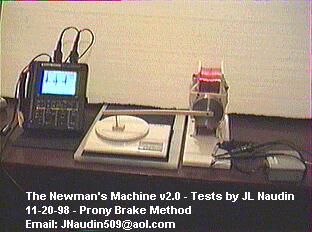

The Newman's Energy Machine
Towards Free Energy ?...
By JL Naudin/M.David
created on 11-20-98 - JLN Labs - last update on 11-22-98
11-20-98 - FIRST OVERUNITY RESULTS ( Mechanical Output Power > AVG Electrical Input Power )
Today (11-20-98), I have reconducted new
measurements about the mechanical efficiency of my Newman's
Energy machine v2.0. I have used a new digital oscilloscope
(Tektronix THS720P ), with this instrument, I have been able to
measure in real time and accurately the electrical power
input, in spite of the strong and short spikes of back
current.
The mechanical power power ouput has been measured with the Prony Brake method.
The mechanical power output from the Newman's machine was measured by calculating the frictionnal torque load on the motor shaft and multiplying this by the rotational speed of the motor (measured with the scope). The mechanical brake used in this test was the simplest and most straight forward technique to measure and vary shaft power, which is very simply defined as torque times rotational speed (Power=Torque * Rotational_speed).

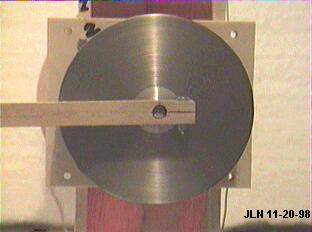
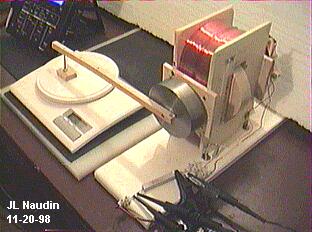
The Prony brake installed on my Newmans'
Machine v2.0
with a digital electronic balance.
I have used only an lenght of 0.25m for the Prony brake lever and conducted 5 measurements. Between each measurements, I have checked that the balance has been previously set to zero.
I have used a Tektronix THS720P Isolated Channel Scope/DMM (tm). It combines a full-featured 100Mhz bandwith and 500 MS/s sample rate digital realtime scope. This scope includes features specialy for electric/power electronics measurements which allow testing and measuring the electrical power in realtime with statistics and math calculations.
My first "historical" test was conducted with the Prony Brake set to 6 grammes:
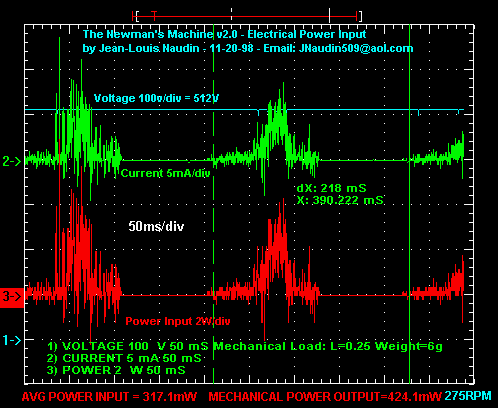
This is the Voltage/Current/Power measurement on the THS720P scope
The scope picture above shows the voltage accross
the power supply ( blue curve ), the current input ( green curve
), and the real time calculated power input ( red curve ). The
prony brake level lenght was 0.25 meter and the weight measured
was 6 grammes. The rotation speed was 275 RPM ( period=218 ms).
The average power input measured with the
scope was 317.1 mW. The mechanical
power output measured on the shaft was 424.1 mW.
This give a mechanical efficiency of 134% (see the hardcopy of the scope picture bellow)

Encouraged with
these interesting results, I have decided to conduct others
measurements.
So, I have conducted 3 others tests :
1) Prony Brake setup: L = 0.25m, Weight = 4
grammes,
Electrical Average Power Input = 120.9mW
Mechanical Power Output = 305.1mW
at 297RPM
Efficiency = 252%
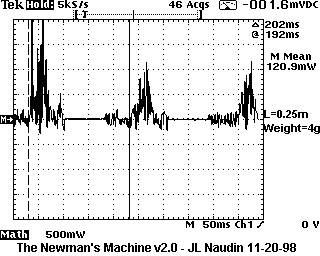
2) Prony Brake setup: L = 0.25m, Weight = 8
grammes,
Electrical Average Power input = 369.1mW
Mechanical Power Output = 522.35mW
at 254RPM
Efficiency
= 142%

3) Prony Brake setup: L = 0.25m, Weight = 10
grammes,
Electrical Average Power Input = 612.5mW
Mechanical Power Output = 642.06mW
at 254RPM
Efficiency
= 105%
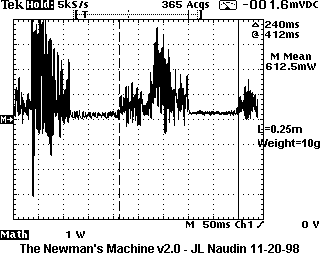
Without mechanical load on the shaft, the
electrical Power Input was about 205.2 mW at 333RPM
The Joules losses in the coil are included in the Electrical
Power Input....

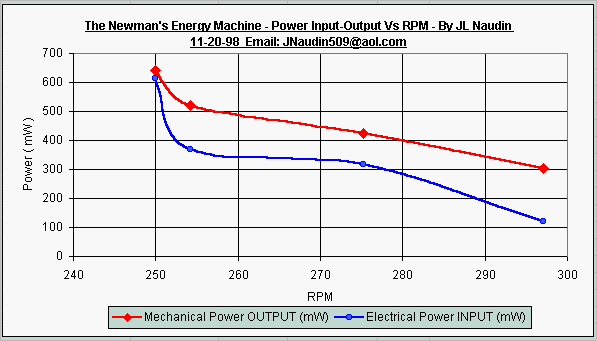
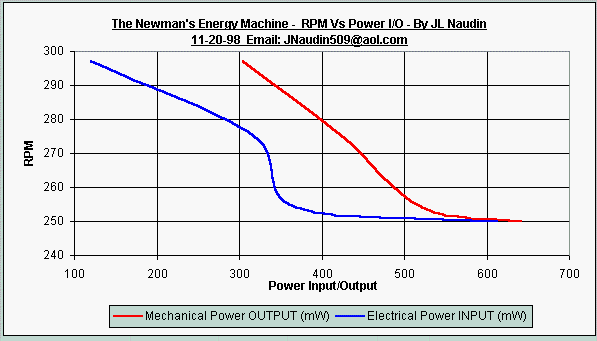
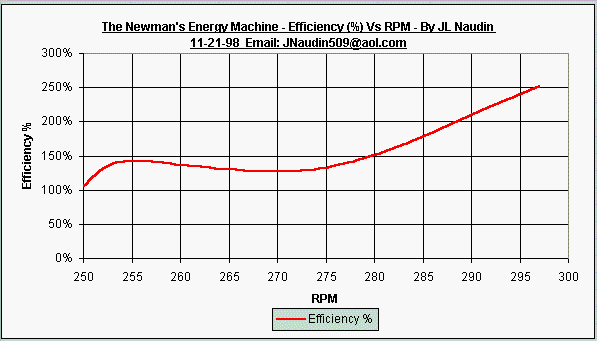
click here to see the Newman's Machine test video with my comments (153kb)
( if you don't have the RealPlayer 5.0, you may download it freely at : http://www.real.com/products/player/ )
You may see also: Back current flow measurement with various setups of scope grounding (12-01-98)
Tests are not yet finished, the way is now open.....
Jean-Louis Naudin
If you need more informations or if you have any suggestions send me your Feedback
![]() Email
: JNaudin509@aol.com
Email
: JNaudin509@aol.com
Return to the Newman's Machine Main page